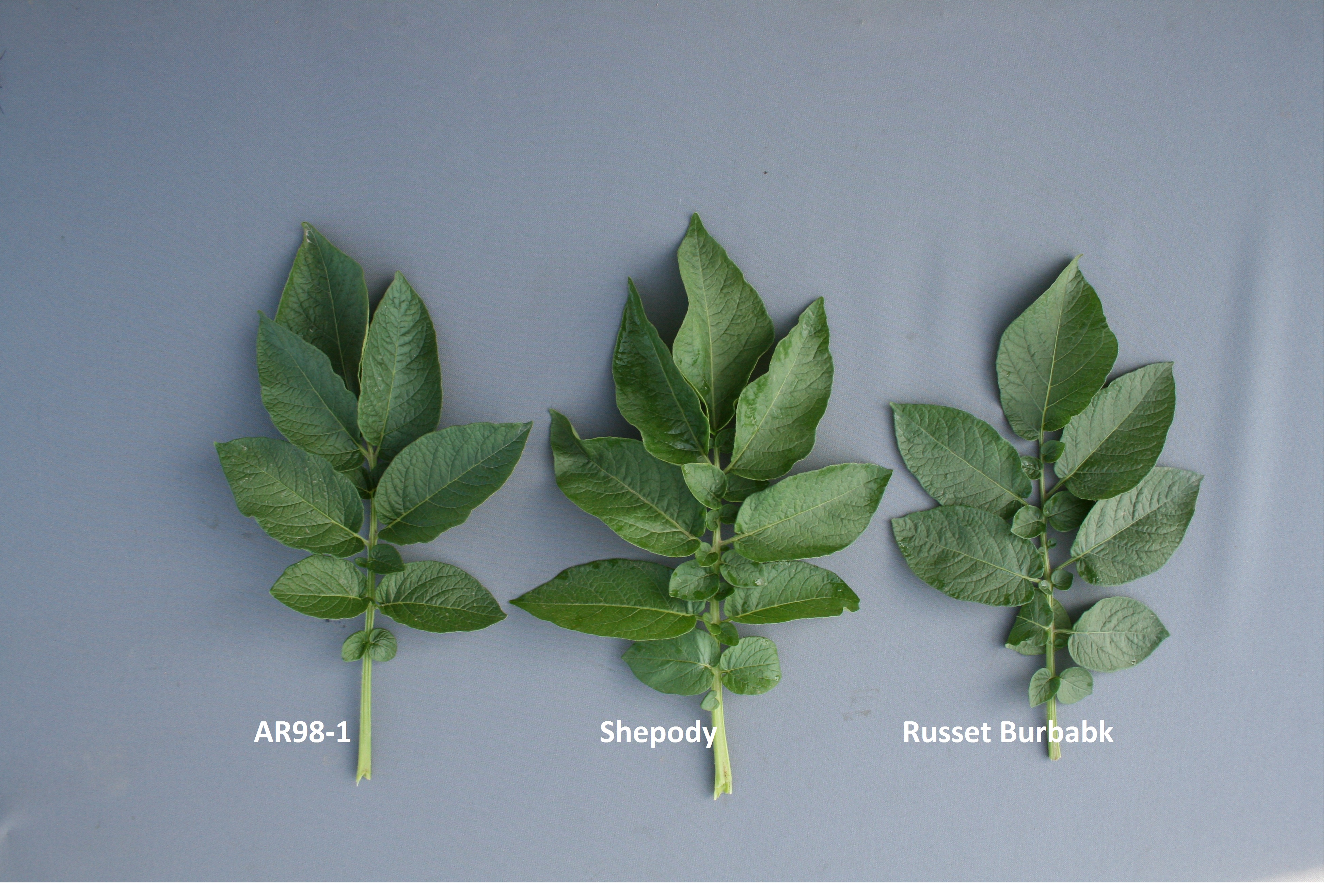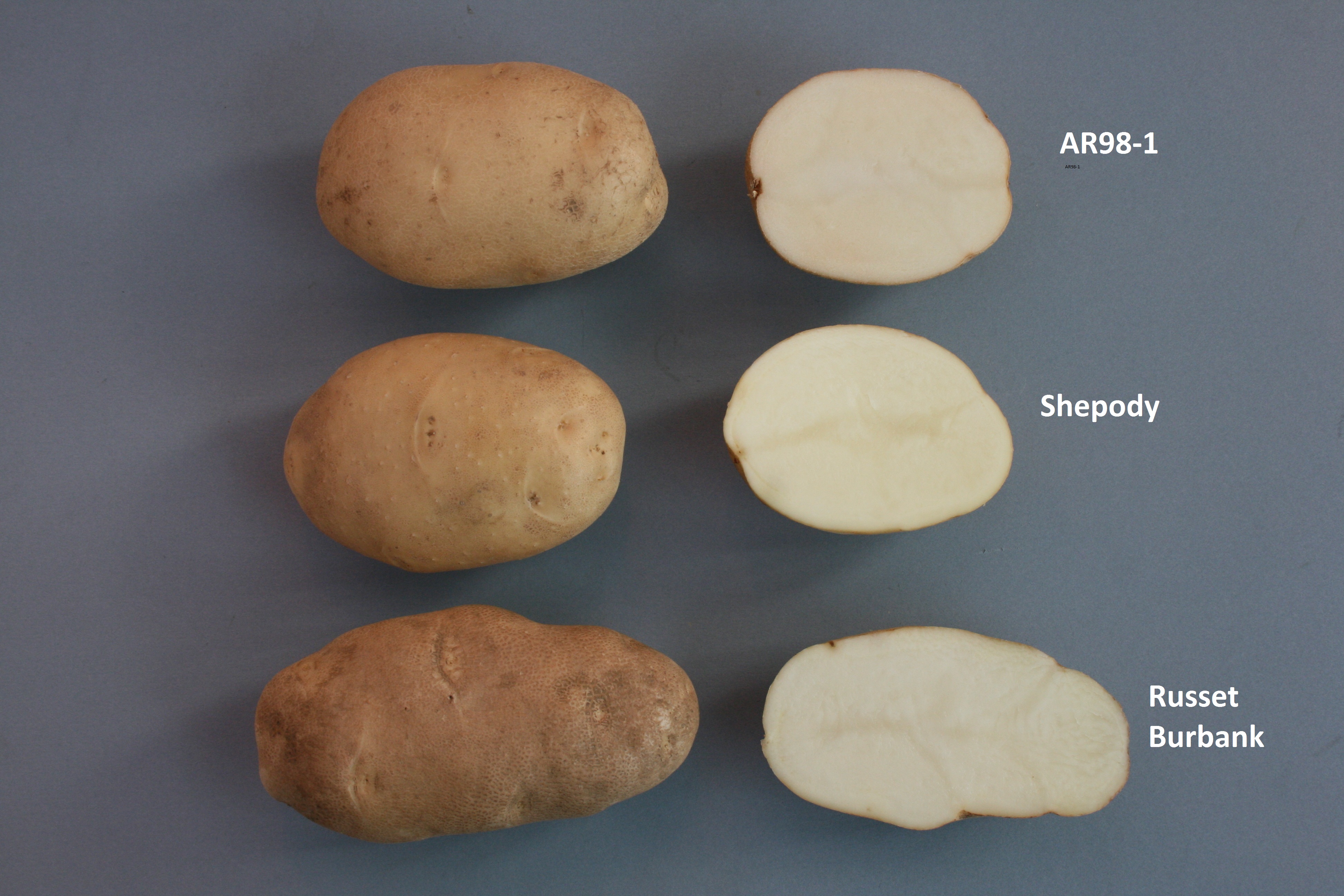BelJade
| Denomination: | 'BelJade' |
|---|---|
| Botanical Name: | Solanum tuberosum |
| Applicant/Holder: |
Agriculture & Agri-Food Canada, Fredericton Fredericton Research and Development Centre 850 Lincoln Road, P.O. Box 20280 Fredericton, New Brunswick E3B 4Z7 Canada |
| Breeder: |
T. Richard Tarn, Agriculture & Agri-Food Canada, Fredericton, New Brunswick |
| Agent in Canada: |
Agriculture & Agri-Food Canada Office of Intellectual Property and Commercialization c/o Shannon Whyte 107 Science Place Saskatoon, Saskatchewan S7N 0X2 Canada Tel: (204) 999-9887 |
| Application Date: | 2011-11-01(priority claimed) |
| Application Number: | 11-7409 |
| Protective direction granted: | 2011-11-01 |
| Protective direction withdrawn: | 2012-07-20 |
| Grant of Rights Date: | 2013-11-27 |
| Certificate Number: | 4654 |
| Date rights surrendered: | 2019-11-27 |
Variety Description
Varieties used for comparison: 'Shepody' and 'Russet Burbank'
Summary: The intensity of anthocyanin colouration at the base of the light sprout is strong for 'BelJade' whereas it is medium for 'Shepody' and 'Russet Burbank'. 'BelJade' has sparse pubescence at the base of the light sprout whereas for 'Shepody' it is dense and for 'Russet Burbank' it is moderately dense. The presence of secondary leaflets on the leaf of 'BelJade' is weak while it is medium to strong for 'Shepody' and medium for 'Russet Burbank'. The extent of anthocyanin colouration of the flower bud is absent for 'BelJade' whereas it is medium for 'Russet Burbank'. The intensity of anthocyanin colouration on the inner side of the corolla is absent or very weak for 'BelJade' while it is weak to medium with a low to medium extent for 'Shepody'. The plants of 'BelJade' mature mid-season while those of 'Russet Burbank' mature late. The shape of the tubers of 'BelJade' is long-oval whereas it is long for 'Russet Burbank'. The colour of the tuber skin is light beige for 'BelJade' whereas it is reddish brown for 'Russet Burbank'.
Description:
LIGHT SPROUT: medium size, spherical, many root tips, medium length lateral shoots
LIGHT SPROUT BASE: strong intensity of anthocyanin colouration, low proportion of blue in anthocyanin colouration, sparse pubescence
LIGHT SPROUT TIP: small in relation to base, closed habit, weak intensity of anthocyanin colouration, sparse pubescence
PLANT: foliage structure is intermediate type where foliage is half open and stems are partly visible, semi-upright growth habit, mid-season maturity
STEM: extent of anthocyanin colouration is absent
LEAF: medium size outline, closed to intermediate openness, presence of secondary leaflets is weak, medium green on upper side, no anthocyanin colouration of midrib of upper side
SECOND PAIR OF LATERAL LEAFLETS: medium size, width in relation to length is narrower than long
LEAFLETS: frequency of coalescence of terminal and lateral leaflets is very low, medium waviness of margin, medium deep veins on upper side, dull upper side, no pubescence of blade in apical rosette
INFLORESCENCE: medium to high frequency per plant, medium size, extent of anthocyanin colouration on peduncle is very low
FLOWER BUD: extent of anthocyanin colouration is absent
COROLLA: medium to large, absent or very weak intensity of anthocyanin colouration on inner side, absent or low proportion of blue in anthocyanin colouration on inner side, extent of anthocyanin colouration on inner side is absent or very low
TUBER: long-oval, light beige skin, shallow eyes, base of eyes is white, cream coloured flesh
Origin & Breeding History: 'BelJade' (experimental designations F93038, AR98-1) originated from a cross made in 1991 at the Potato Research Centre of Agriculture and Agri-Food Canada in Fredericton, New Brunswick. The cross was conducted using two breeding clones; the female parent designated 'CS74109-8' and the male parent designated 'F66011'. In 1991, true potato seed was planted in a greenhouse in Fredericton and the resulting seedling tubers were planted in 1992 at the Benton Research Substation for selection. A clone designated F93038 was selected in 1992 during the accelerated release stage. It progressed through the 4-hill and 20-hill generation stages of selection and evaluation at the Benton Research Substation in 1993 and 1994, respectively. Selection criteria in the field in Benton and in the laboratory in Fredericton included vine maturity and vigour, shape and size of tuber, specific gravity, culinary quality, fry colour, incidence of tuber defects, and reaction to diseases including common scab. F93038 was renamed AR98-1 in 1998 during the accelerated release stage.
Tests & Trials: The trial for 'BelJade' was conducted in 2012 at the Potato Research Centre of Agriculture and Agri-Food Canada in Fredericton, New Brunswick. There were 2 replicates per variety. Each replicate was 7.5 metres long with 0.9 metre spacing between rows. The plants were spaced 0.25 metres apart within the row. In total, there were 60 plants per variety.
Click on image for larger view

Potato: 'BelJade' (left) with reference varieties 'Shepody' (centre) and 'Russet Burbank' (right)
Click on image for larger view

Potato: 'BelJade' (left) with reference varieties 'Shepody' (centre) and 'Russet Burbank' (right)
Click on image for larger view

Potato: 'BelJade' (top) with reference varieties 'Shepody' (centre) and 'Russet Burbank' (bottom)
- Date modified: